Synthesis, Characterisation, and In Vitro Evaluation of Biocompatibility, Antibacterial and Antitumor Activity of Imidazolium Ionic Liquids
Abstract
:1. Introduction
2. Materials and Methods
2.1. Materials
2.2. General Description of IL Syntheses
2.2.1. Alkylation Procedure
2.2.2. Metathesis Procedure
2.3. Blend Film Preparation
2.4. Characterisation
2.4.1. Nuclear Magnetic Resonance (NMR) Spectroscopy
2.4.2. Matrix-Assisted Laser Desorption Time of Flight Mass Spectrometry (MALDI-TOF MS) Analysis
2.4.3. Thermal Analysis: Differential Scanning Calorimetry (DSC) and Thermogravimetric Analysis (TGA)
2.4.4. Scanning Electron Microscopy (SEM)
2.4.5. Contact Angle (CA)
2.4.6. IL Release from the Blend Films
2.4.7. Antibacterial Screening
Bacterial Strain Growth
Antibacterial Tests
2.4.8. Biocompatibility/Cytotoxicity
Cell Cultures
Cytotoxicity Tests for IL Powders
Cytocompatibility Tests for IL-Loaded Polymer Substrates
2.4.9. Statistical Analysis
3. Results and Discussion
3.1. IL Synthesis, Characterisation, and Fabrication of PVC/IL Film Blends
3.2. Thermal Analysis of ILs and PVC/IL Blends
3.3. Morphological Investigations: Scanning Electron Microscopy (SEM)
3.4. Contact Angle Measurements
3.5. IL Release from the PVC/IL Blends
3.6. Antibacterial Activity
3.6.1. Antibacterial Activity of Neat ILs
3.6.2. Antibacterial Activity of PVC/IL Blend Films
3.7. Biocompatibility/Toxicity of ILs
4. Conclusions
Supplementary Materials
Author Contributions
Funding
Institutional Review Board Statement
Data Availability Statement
Conflicts of Interest
Abbreviations
| Ionic Liquids | |
| Cations | |
| C9mim | 1-methyl-3-nonylimidazolium |
| C10mim | 1-decyl-3-methylimidazolium |
| C12mim | 1-dodecyl-3-methylimidazolium |
| C14mim | 1-methyl-3-tetradecylimidazolium |
| C16mim | 1-hexyl-3-methylimidazolium |
| C18mim | 1-methyl-3-octadecylimidazolium |
| C20mim | 1-eicosyl-3-methylimidazolium |
| Anions | |
| BF4 | tetrafluoroborate |
| DMSIP | 1,3-dimethyl 5-sulfoisophthalate |
| Bacteria | |
| L. monocytogenes | Listeria monocytogenes |
| E. coli | Escherichia coli |
| P. fluorescens | Pseudomonas fluorescens |
| Human cell lines | |
| MCF7 | human breast cancer cells |
| HDF | human dermal fibroblast cells |
References
- Spellberg, B.; Guidos, R.; Gilbert, J.B.; Boucher, H.W.; Scheld, M.; Bartlett, J.G.; Edwards, J. The Epidemic of Antibiotic-Resistant Infections: A Call to Action for the Medical Community from the Infectious Diseases Society of America. Clin. Infect. Dis. 2008, 46, 155–164. [Google Scholar] [CrossRef] [PubMed]
- Allegranzi, B.; Nejad, S.B.; Combescure, C.; Graafmans, W.; Attar, H.; Donaldson, L.; Pittet, D. Burden of endemic health-care-associated infection in developing countries: Systematic review and meta-analysis. Lancet 2011, 377, 228–241. [Google Scholar] [CrossRef] [PubMed]
- Frieri, M.; Kumar, K.; Boutin, A. Antibiotic resistance the global threat. J. Infect. Public Health 2017, 10, 369–378. [Google Scholar] [CrossRef] [PubMed]
- Cui, Y.T.; Teo, S.L.M.; Leong, W.; Chai, C.L.L. Searching for “Environmentally-Benign” Antifouling Biocides. Int. J. Mol. Sci. 2014, 15, 9255–9284. [Google Scholar] [CrossRef] [PubMed]
- Demberelnyamba, D.; Kim, K.-S.; Choi, S.; Park, S.-Y.; Lee, H.; Kim, C.-J.; Yoo, I.-D. Synthesis and antimicrobial properties of imidazolium and pyrrolidinonium salts. Bioorgan. Med. Chem. 2004, 12, 853–857. [Google Scholar] [CrossRef] [PubMed]
- Anderson, E.B.; Long, T.E. Imidazole- and imidazolium-containing polymers for Biology and material science applications. Polymer 2010, 51, 2447–2454. [Google Scholar] [CrossRef]
- Zampino, D.; Ferreri, T.; Puglisi, C.; Mancuso, M.; Zaccone, R.; Scaffaro, R.; Bennardo, D. PVC silver zeolite composites with antimicrobial properties. J. Mater. Sci. 2011, 46, 6734–6743. [Google Scholar] [CrossRef]
- Carmona-Ribeiro, A.M.; Dias de Melo Carrasco, L. Cationic Antimicrobial Polymers and Their Assemblies. Int. J. Mol. Sci. 2013, 14, 9906–9946. [Google Scholar] [CrossRef] [PubMed]
- Ashraf, M.A.; Ullah, S.; Ahmad, I.; Qureshi, A.K.; Balkhairf, K.S.; Rehman, M.A. Green biocides, a promising technology: Current and future applications to industry and industrial processes. J. Sci. Food Agric. 2013, 94, 388–403. [Google Scholar] [CrossRef]
- Bahar, A.A.; Ren, D. Antimicrobial peptides. Pharmaceuticals 2013, 6, 1543–1575. [Google Scholar] [CrossRef]
- Cheng, G.C.; Dai, M.; Ahmed, S.; Hao, H.; Wang, X.; Yuan, Z. Antimicrobial Drugs in Fighting against Antimicrobial Resistence. Front. Microbiol. 2016, 7, 470. [Google Scholar] [CrossRef]
- Egorova, K.S.; Gordeev, E.G.; Ananikov, V.P. Biological activity of ionic liquids and their application in pharmaceutics and medicine. Chem. Rev. 2017, 117, 7132–7189. [Google Scholar] [CrossRef] [PubMed]
- Mancuso, M.; Catalfamo, M.; Laganà, P.; Rappazzo, A.C.; Raymo, V.; Zampino, D.C.; Zaccone, R. Screening of antimicrobial activity of citrus essential oils against pathogenic bacteria and Candida strains. Flavour. Fragr. J. 2019, 34, 187–200. [Google Scholar] [CrossRef]
- Kamaruzzaman, N.F.; Tan, L.P.; Hamdan, R.H.; Choong, S.S.; Wong, W.K.; Gibson, A.J.; Chivu, A.; Pina, M.F. Antimicrobial polymers: The potential replacement of existing antibiotics? Int. J. Mol. Sci. 2019, 20, 2747. [Google Scholar] [CrossRef] [PubMed]
- Clarizia, G.; Bernardo, P.; Carroccio, S.C.; Ussia, M.; Restuccia, C.; Parafati, L.; Calarco, A.; Zampino, D. Heterogenized imidazolium-based ionic liquids in Pebax Rnew. Thermal, gas transport and antimicrobial properties. Polymers 2020, 12, 1419. [Google Scholar] [CrossRef] [PubMed]
- Zampino, D.; Pedotti, S.; Ussia, M.; Dattilo, S.; Mancuso, M.; Zaccone, R.; Patti, A. Preparation, characterisation, and antimicrobial activity of ferrocene-containing polymeric materials. J. Appl. Polym. Sci. 2021, 138, 49852. [Google Scholar] [CrossRef]
- Zampino, D.; Mancuso, M.; Zaccone, R.; Ferreri, T.; Borzacchiello, A.; Zeppetelli, S.; Dattilo, S.; Ussia, M.; Ferreri, L.; Carbone, D.C.; et al. Thermo-mechanical, antimicrobial and biocompatible properties of PVC blends based on imidazolium ionic liquids. Mater. Sci. Eng. C 2021, 122, 111920. [Google Scholar] [CrossRef] [PubMed]
- Ferreri, L.; Consoli, G.M.L.; Clarizia, G.; Zampino, D.C.; Nostro, A.; Granata, G.; Ginestra, G.; Giuffrida, M.L.; Zimbone, S.; Bernardo, P. A novel material based on an antibacterial cholinecalixarene nanoassembly embedded in thin films. J. Mater. Sci. 2022, 57, 20685–20701. [Google Scholar] [CrossRef]
- Zampino, D.C.; Samperi, F.; Mancuso, M.; Ferreri, T.; Ferreri, L.; Dattilo, S.; Mirabella, E.F.; Carbone, D.C.; Recca, G.; Scamporrino, A.A.; et al. Polymer Blends Based on 1-Hexadecyl-3-methyl Imidazolium 1,3-Dimethyl 5-Sulfoisophthalate Ionic Liquid: Thermo-Mechanical, Surface Morphology and Antibacterial Properties. Polymers 2023, 15, 970. [Google Scholar] [CrossRef]
- Belay, K.; Abisa, Z. Properties, applications and synthesis of ionic liquids in Chemistry: A review. World J. Pharm. Med. Res. 2015, 1, 32–39. [Google Scholar]
- Welton, T. Ionic Liquids: A brief history. Biophys. Rev. 2018, 10, 691–706. [Google Scholar] [CrossRef]
- Patel, R.; Kumari, M.; Khan, A.B. Recent advances in the applications of ionic liquids in protein stability and activity: A review. Appl. Biochem. Biotechnol. 2014, 172, 3701–3720. [Google Scholar] [CrossRef] [PubMed]
- Gilmore, B.F. Antimicrobial Ionic Liquids. In Ionic Liquids: Applications and Perspectives; Alexander, K., Ed.; InTech: Sydney, Australia, 2011; Volume 26, pp. 587–600. Available online: https://www.intechopen.com/chapters/13744 (accessed on 8 January 2021).
- Lu, J.; Yan, F.; Texter, J. Advanced applications of ionic liquids in polymer science. Prog. Polym. Sci. 2009, 34, 431–448. [Google Scholar] [CrossRef]
- Welton, T. Room-Temperature ionic liquids. Solvents for synthesis and catalysis. Chem. Rev. 1999, 99, 2071–2083. [Google Scholar] [CrossRef]
- Kaur, G.; Kumar, H.; Singla, M. Diverse applications of ionic liquids: A comprehensive review. J. Mol. Liq. 2022, 351, 118556. [Google Scholar] [CrossRef]
- Olivier-Bourbigou, H.; Magna, L.; Morvan, D. Ionic Liquids and Catalysis: Recent progress from knowledge to applications. Appl. Catal. A Gen. 2010, 373, 1–56. [Google Scholar] [CrossRef]
- Vekariya, R.L. A review of ionic liquids: Applications towards catalytic. J. Mol. Liq. 2017, 227, 44–60. [Google Scholar] [CrossRef]
- De Bon, F.; Fantin, M.; Isse, A.A.; Gennaro, A. Electrochemically mediated ATRP in ionic liquids: Controlled polymerization of methyl acrylate in [BMIm][OTf]. Polym. Chem. 2018, 9, 646–655. [Google Scholar] [CrossRef]
- Wei, D.; Ivaska, A. Applications of ionic liquids in electrochemical sensors. Anal. Chim. Acta 2008, 607, 126–135. [Google Scholar] [CrossRef]
- Livi, S.; Duchet-Rumeau, J.; Gérard, J.-F.; Pham, T.N. Polymers and ionic liquids: A successful wedding. Macromol. Chem. Phys. 2015, 216, 359–368. [Google Scholar] [CrossRef]
- Ferraz, R.; Branco, L.C.; Prudêncio, C.; Noronha, J.P.; Petrovski, Ž. Ionic liquids as active pharmaceutical ingredients. ChemMedChem 2011, 6, 975–985. [Google Scholar] [CrossRef] [PubMed]
- Bugatti, V.; Viscusi, G.; Di Bartolomeo, A.; Iemmo, L.; Zampino, D.C.; Vittoria, V.; Gorrasi, G. Ionic liquid as dispersing agent of LDH-Carbon Nanotubes into a biodegradable vinyl alcohol polymer. Polymers 2020, 12, 495. [Google Scholar] [CrossRef] [PubMed]
- Bernardo, P.; Zampino, D.; Clarizia, G. Triggering the gas transport in PVdF-HFP membranes via imidazolium ionic liquids. Sep. Purif. Technol. 2020, 250, 117201. [Google Scholar] [CrossRef]
- Zampino, D.C.; Clarizia, G.; Bernardo, P. Temperature Responsive copolymers films of Polyether and bio-based Polyamide loaded with imidazolium ionic liquids for Smart packaging applications. Polymers 2023, 15, 1147. [Google Scholar] [CrossRef]
- Zhuo, Y.; Cheng, H.-L.; Zhao, Y.-G.; Cui, H.-R. Ionic liquids in pharmaceutical and biomedical applications: A review. Pharmaceutics 2024, 16, 151. [Google Scholar] [CrossRef]
- Pendleton, N.; Gilmore, B.F. The antimicrobial potential of ionic liquids: A source of chemical diversity for infection and biofilm control. Int. J. Antimicrob. Agents 2015, 46, 131–139. [Google Scholar] [CrossRef] [PubMed]
- Zheng, Z.; Xu, Q.; Guo, J.; Qin, J.; Mao, H.; Wang, B.; Yan, F. Structure−Antibacterial activity Relationships of imidazolium-type ionic liquid monomers, poly(ionic liquids) and poly(ionic liquid) membranes: Effect of Alkyl Chain Length and Cations. Appl. Mater. Interfaces 2016, 8, 12684–12692. [Google Scholar] [CrossRef]
- Anvari, S.; Hajfarajollah, H.; Mokhtarani, B.; Enayati, M.; Sharifi, A.; Mirzaei, M. Antibacterial and anti-adhesive properties of ionic liquids with various cationic and anionic heads toward pathogenic bacteria. J. Mol. Liq. 2016, 221, 685–690. [Google Scholar] [CrossRef]
- Yang, D.D.; Paterna, N.J.; Senetra, A.S.; Casey, K.R.; Trieu, P.D.; Caputo, G.A.; Vaden, T.D.; Carone, B.R. Synergistic interactions of ionic liquids and antimicrobials improve drug efficacy. iScience 2021, 24, 101853. [Google Scholar] [CrossRef]
- Wu, X.; Yu, Q.; Wu, J.; Li, T.; Ding, N.; Wu, W.; Lu, Y.; Zhu, Q.; Chen, Z.; Qi, J. Ionic liquids containing ketoconazole improving topical treatment of T. interdigitale infection by synergistic action. Int. J. Pharm. 2020, 589, 119842. [Google Scholar] [CrossRef]
- Wu, X.; Shen, M.; Wang, H.; He, X.; Tan, J.; Wang, R.; Yang, H.; Qi, J.; Chen, Z.; Zhu, Q. Evaluation of the efficacy and safety of ionic liquids containing ketoconazole in patients with tinea pedis: A randomized controlled clinical trial. Bioeng. Transl. Med. 2023, 8, e10463. [Google Scholar] [CrossRef]
- Scott, M.P.; Rahman, M.; Brazel, C.S. Application of ionic liquids as low-volatility plasticizers for PMMA. Eur. Polym. J. 2003, 39, 1947–1953. [Google Scholar] [CrossRef]
- Rahman, M.; Brazel, C.S. Ionic liquids: New generation stable plasticizers for poly(vinyl chloride). Polym. Degrad. Stab. 2006, 91, 3371–3382. [Google Scholar] [CrossRef]
- Hou, L.X.; Wang, S. Study on ionic liquid [bmim]PF6 and [hmim]PF6 as plasticizer for PVC paste resin. Polym. Bull. 2011, 67, 1273–1283. [Google Scholar] [CrossRef]
- Choi, S.Y.; Rodrìguez, H.; Mirjafari, A.; Gilpin, D.F.; McGrath, S.; Malcolm, K.R.; Tunney, M.M.; Rogers, R.D.; McNally, T. Dual functional ionic liquids as plasticisers and antimicrobial agents for medical polymers. Green Chem. 2011, 13, 1527. [Google Scholar] [CrossRef]
- Choi, Y.; Rodrìguez, H.; Gunaratne, H.Q.N.; Puga, A.V.; Gilpin, D.; McGrath, S.; Vyle, J.S.; Tunney, M.M.; Rogers, R.D.; McNally, T. Dual functional ionic liquids as antimicrobials and plasticisers for medical grade PVCs. RSC. Adv. 2014, 4, 8567–8581. [Google Scholar] [CrossRef]
- Colonna, M.; Berti, C.; Binassi, E.; Fiorini, M.; Sullalti, S.; Acquasanta, F.; Vannini, M.; Di Gioia, D.; Aloisio, I. Imidazolium poly(butylene terephthalate) ionomers with long-term antimicrobial activity. Polymer 2012, 53, 1823–1830. [Google Scholar] [CrossRef]
- Rogalsky, S.; Fatyeyeva, K.; Lyoshina, L.; Tarasyuk, O.; Bulko, O.; Lobok, S. Antimicrobial Properties and Thermal Stability of Polycarbonate Modified with 1-Alkyl-3-methylimidazolium Tetrafluoroborate Ionic Liquids. J. Appl. Polym. Sci. 2014, 131, 40050–40056. [Google Scholar] [CrossRef]
- Guo, N.; Hu, D.; Wang, H.; Wang, R.; Xiong, Y. Functional poly (ethylene terephthalate) materials prepared by condensation copolymerization with ionic liquids. Polym. Bull. 2013, 70, 3031–3040. [Google Scholar] [CrossRef]
- Schrekker, C.M.L.; Sokolovicz, Y.C.A.; Raucci, M.G.; Selukar, B.S.; Klitzke, J.S.; Lopes, W.; Leal, C.A.M.; De Souza, I.O.P.; Galland, G.B.; Dos Santos, J.H.Z.; et al. Multitask Imidazolium Salt Additives for Innovative Poly(l-lactide) Biomaterials: Morphology Control, Candida spp. Biofilm Inhibition, Human Mesenchymal Stem Cell Biocompatibility, and Skin Tolerance. ACS Appl. Mater. Interfaces 2016, 8, 21163–21176. [Google Scholar] [CrossRef]
- Raucci, M.G.; Fasolino, I.; Pastore, S.G.; Soriente, A.; Capeletti, L.B.; Dessuy, M.B.; Giannini, C.; Schrekker, H.S.; Ambrosio, L. Antimicrobial Imidazolium Ionic Liquids for the Development of Minimal Invasive Calcium Phosphate-Based Bionanocomposites. ACS Appl. Mater. Interfaces 2018, 10, 42766–42776. [Google Scholar] [CrossRef] [PubMed]
- Frade, R.F.M.; Matias, A.; Branco, L.C.; Afonso, C.A.M.; Duarte, C.M.M. Effect of ionic liquids on human colon carcinoma HT-29 and CaCo-2 cell lines. Green Chem. 2007, 9, 873–877. [Google Scholar] [CrossRef]
- Kumar, R.A.; Papaïconomou, N.; Lee, J.M.; Salminen, J.; Clark, D.S.; Prausnitz, J.M. In vitro cytotoxicities of ionic liquids: Effect of cation rings, functional groups, and anions. Environ. Toxicol. 2009, 24, 388–395. [Google Scholar] [CrossRef] [PubMed]
- Frade, R.F.M.; Rosatella, A.A.; Marques, C.S.; Branco, L.C.; Kulkarni, P.S.; Mateus, N.M.M.; Afonso, C.A.M.; Duarte, C.M.M. Toxicological evaluation on human colon carcinoma cell line (CaCo-2) of ionic liquids based on imidazolium, guanidinium, ammonium, phosphonium, pyridinium and pyrrolidinium cations. Green Chem. 2009, 11, 1660–1665. [Google Scholar] [CrossRef]
- Malhotra, S.V.; Kumar, V. A profile of the in vitro anti-tumor activity of imidazolium-based ionic liquids. Bioorg. Med. Chem. Lett. 2010, 20, 581–585. [Google Scholar] [CrossRef] [PubMed]
- Dias, A.R.; Costa-Rodrigues, J.; Fernandes, M.H.; Ferraz, R. The anticancer potential of ionic liquids. ChemMedChem 2017, 12, 11–18. [Google Scholar] [CrossRef] [PubMed]
- Gonçalves, A.R.P.; Paredes, X.; Cristino, A.F.; Santos, F.J.V.; Queirós, C.S.G.P. Ionic Liquids-A review of their toxicity to living organisms. Int. J. Mol. Sci. 2021, 22, 5612. [Google Scholar] [CrossRef] [PubMed]
- Benedetto, A. Ionic liquids meet lipid bilayers: A state-of-the-art review. Biophys. Rev. 2023, 15, 1909–1939. [Google Scholar] [CrossRef]
- Huda, M.N.; Deaguero, I.G.; Borrego, E.A.; Kumar, R.; Islam, T.; Afrin, H.; Valera-Ramirez, A.; Aguilera, R.J.; Tanner, E.E.I.; Nurunnabi, M. Ionic liquid-mediated delivery of a BCL-2 inhibitor for topical treatment of skin melanoma. J. Control. Release 2022, 349, 783–795. [Google Scholar] [CrossRef]
- Bakshi, K.; Mitra, S.; Sharma, V.K.; Jayadev, M.S.K.; Sakai, V.G.; Mukhopadhyay, R.; Gupta, A.; Ghosh, S.K. Imidazolium-based ionic liquids cause mammalian cell death due to modulated structures and dynamics of cellular membrane. Biochim. Biophys. Acta (BBA) Biomembr. 2020, 1862, 183103. [Google Scholar] [CrossRef]
- da Silva, D.J.; Gramcianinov, G.B.; Jorge, P.Z.; Malaquias, V.B.; Mori, A.A.; Hirata, M.H.; Lopes, S.A.M.; Bueno, L.A.; Champeau, M.; Carastan, D.J. PVC containing silver nanoparticles with antimicrobial properties effective against SARS-CoV-2. Front. Chem. 2023, 11, 1083399. [Google Scholar] [CrossRef]
- Poirel, L.; Madec, J.-Y.; Lupo, A.; Schink, A.-K.; Kieffer, N.; Nordmann, P.; Schwarz, S. Antimicrobial resistance in Escherichia coli. Microbiol. Spectr. 2018, 6, ARBA-0026-2017. [Google Scholar] [CrossRef] [PubMed]
- Luque-Sastre, L.; Arroyo, C.; Fox, E.M.; McMahon, B.J.; Bai, L.; Séamus, L.F. Antimicrobial Resistance in Listeria Species. ASM J. Microbiol. Spectr. 2018, 6, ARBA-0031-2017. [Google Scholar] [CrossRef]
- Silverio, M.P.; Kraychete, G.B.; Rosado, A.S.; Bonelli, R.R. Pseudomonas fluorescens Complex and Its Intrinsic, Adaptive, and Acquired Antimicrobial Resistance Mechanisms in Pristine and Human-Impacted Sites. Antibiotics 2022, 11, 985. [Google Scholar] [CrossRef]
- CLSI M07-A10; Methods for Dilution Antimicrobial Susceptibility Tests for Bacteria That Grow Aerobically. Approved Standard—Tenth Edition; Clinical and Laboratory Standards Institute: Wayne, PA, USA, 2015. Available online: https://clsi.org/media/1632/m07a10_sample.pdf (accessed on 24 April 2020).
- Wallin, R.F.; Arscott, E.F. A Practical Guide to ISO 10993-5: Cytotoxicity; Medical Device and Diagnostic Industry: London, UK, 1998. [Google Scholar]
- ISO 10993-12:2021(En); Biological Evaluation of Medical Devices—Part 12: Sample Preparation and Reference Materials. ISO: Geneva, Switzerland, 2021. Available online: https://www.iso.org/standard/75769.html (accessed on 16 August 2021).
- Raucci, M.G.; Adesanya, K.; Di Silvio, L.; Catauro, M.; Ambrosio, L. The biocompatibility of silver-containing Na2O·CaO·2SiO2 glass prepared by sol-gel method: In vitro studies. J. Biomed. Mater. Res. Part B Appl. Biomater. 2010, 92, 102–110. [Google Scholar] [CrossRef] [PubMed]
- Gómez, E.; Calvar, N.; Domínguez, Á. Thermal behavior of pure ionic liquids. In Ionic Liquids—Current State of Art; Handy, S., Ed.; InTech Open Science: London, UK, 2015; Volume 8, pp. 199–228. ISBN 978-953-51-2122-0. [Google Scholar] [CrossRef]
- Fradelake, C.P.; Crosthwaite, J.M.; Hert, D.G.; Aki, S.N.V.K.; Brennecke, J.F. Thermophysical Properties of Imidazolium-Based Ionic Liquids. J. Chem. Eng. Data 2004, 49, 954–964. [Google Scholar] [CrossRef]
- Holbrey, J.D.; Reichert, W.M.; Swatloski, R.P.; Broker, G.A.; Pitner, W.R.; Seddon, K.R.; Rogers, R.D. Efficient, halide free synthesis of new, low cost ionic liquids: 1,3-Dialkylimidazolium salts containing methyl-and ethyl-sulfate anions. Green Chem. 2002, 4, 407–413. [Google Scholar] [CrossRef]
- Bakulina, O.D.; Ivanov, M.Y.; Prikhod’ko, S.A.; Pylaeva, S.; Zaytseva, I.V.; Surovtsev, N.V.; Adonin, N.Y.; Fedin, M.V. Nanocage formation and structural anomalies in imidazolium ionic liquid glasses governed by alkyl chains of cations. Nanoscale 2020, 12, 19982–19991. [Google Scholar] [CrossRef]
- Bonhôte, P.; Dias, A.-P.; Papageorgiou, N.; Kalyanasundaram, K.; Grätzel, M. Hydrophobic, Highly Conductive Ambient-Temperature Molten Salts. Inorg. Chem. 1996, 35, 1168–1178. [Google Scholar] [CrossRef]
- Ngo, H.L.; LeCompte, K.; Hargens, L.; McEwen, A.B. Thermal properties of imidazolium ionic liquids. Thermochim. Acta 2000, 357–358, 97–102. [Google Scholar] [CrossRef]
- Awad, W.H.; Gilman, J.W.; Nyden, N.; Harris, R.H.; Sutto, T.E.; Callahan, J.; Trulove, P.C.; DeLong, H.C.; Fox, D.M. Thermal degradation studies of alkyl-imidazolium salts and their application in nanocomposites. Thermochim. Acta 2004, 409, 3–11. [Google Scholar] [CrossRef]
- Maton, C.; De Vos, N.; Stevens, C.V. Ionic liquid thermal stabilities: Decomposition mechanisms and analysis tools. Chem. Soc. Rev. 2013, 42, 5963–5977. [Google Scholar] [CrossRef] [PubMed]
- Huddleston, J.G.; Visser, A.E.; Reichert, W.M.; Willauer, H.D.; Broker, G.A.; Rogers, R.D. Characterization and comparison of hydrophilic and hydrophobic room temperature ionic liquids incorporating the imidazolium cation. Green Chem. 2001, 3, 156–164. [Google Scholar] [CrossRef]
- Crosthwaite, J.M.; Muldoon, M.J.; Dixon, J.K.; Anderson, J.L.; Brennecke, J.F. Phase transition and decomposition temperatures, heat capacities and viscosities of pyridinium ionic liquids. J. Chem. Thermodyn. 2005, 37, 559–568. [Google Scholar] [CrossRef]
- Montaudo, G.; Puglisi, C. Evolution of Aromatics in the Thermal-Degradation of Poly(Vinyl Chloride)—A Mechanistic Study. Polym. Degrad. Stab. 1991, 33, 229–262. [Google Scholar] [CrossRef]
- Chau, T.T.; Bruckard, W.J.; Koh, P.T.L.; Nguyen, A.V. A review of factors that affect contact angle and implications for flotation practice. Adv. Colloid Interface Sci. 2009, 150, 106–115. [Google Scholar] [CrossRef] [PubMed]
- Deng, Y.; Besse-Hoggan, P.; Saucelme, M.; Delort, A.-M.; Husson, P.; Gomes, M.F.C.J. Influence of oxygen functionalities on the environmental impact of imidazolium based ionic liquids. Hazard. Mater. 2011, 198, 165–174. [Google Scholar] [CrossRef] [PubMed]
- Nikfarjam, N.; Ghomi, M.; Agarwal, T.; Hassanpour, M.; Sharifi, E.; Khorsandi, D.; Khan, M.A.; Rossi, F.; Rossetti, A.; Zare, E.N.; et al. Antimicrobial Ionic Liquid-Based Materials for Biomedical Applications. Adv. Funct. Mater. 2021, 31, 2104148. [Google Scholar] [CrossRef]
- Evans, K.O. Room-temperature ionic liquid cations act as short-chain surfactants and disintegrate a phospholipid bilayer. Colloids Surf. A Physicochem. Eng. Asp. 2006, 274, 11–17. [Google Scholar] [CrossRef]
- Pernak, J.; Sobaszkiewicza, K.; Mirskab, I. Anti-microbial activities of ionic liquids. Green Chem. 2003, 5, 52–56. [Google Scholar] [CrossRef]
- Łuczak, J.; Jungnickel, C.; Łacka, I.; Stolte, S.; Hupkaa, J. Antimicrobial and surface activity of 1-alkyl-3-methylimidazolium derivatives. Green Chem. 2010, 12, 593–601. [Google Scholar] [CrossRef]
- Benedetto, A.; Bingham, R.J.; Ballone, P. Structure and dynamics of POPC bilayers in water solutions of room temperature ionic liquids. J. Chem. Phys. 2015, 142, 124706. [Google Scholar] [CrossRef] [PubMed]
- Kumari, P.; Pillai, V.V.S.; Benedetto, A. Mechanisms of action of ionic liquids on living cells: The state of the art. Biophys. Rev. 2020, 12, 1187–1215. [Google Scholar] [CrossRef]
- Costa, F.M.S.; Saraiva, M.L.M.F.S.; Passos, M.L.C. Ionic liquids and organic salts with antimicrobial activity as a strategy against resistant microorganisms. J. Mol. Liq. 2022, 368, 120750. [Google Scholar] [CrossRef]
- Florio, W.; Becherini, S.; D’Andrea, F.; Lupetti, A.; Chiappe, C.; Guazzelli, L. Comparative evaluation of antimicrobial activity of different types of ionic liquids. Mater. Sci. Eng. C 2019, 104, 109907. [Google Scholar] [CrossRef] [PubMed]
- Carson, L.; Chau, P.K.W.; Earle, M.J.; Gilea, M.A.; Gilmore, B.F.; Gorman, S.P.; McCann, M.T.; Seddon, K.R. Antibiofilm activities of 1-alkyl-3-methylimidazolium chloride ionic liquids. Green Chem. 2009, 11, 492–497. [Google Scholar] [CrossRef]
- Stromyer, M.L.; Southerland, M.R.; Satyal, U.; Sikder, R.K.; Weader, D.J.; Baughman, J.A.; Youngs, W.J.; Abbosh, P.H. Synthesis, characterization, and biological activity of a triphenylphosphonium-containing imidazolium salt against select bladder cancer cell lines. Eur. J. Med. Chem. 2020, 185, 111832. [Google Scholar] [CrossRef]
- Han, T.-H.; Lee, J.-D.; Seo, B.-C.; Jeon, W.-H.; Yang, H.-A.; Kim, S.; Haam, K.; Park, M.K.; Park, J.; Han, T.-S.; et al. Cancer-specific cytotoxicity of pyridinium-based ionic liquids by regulating hypoxia-inducible factor-1α-centric cancer metabolism. Ecotoxicol. Environ. Saf. 2022, 248, 114334. [Google Scholar] [CrossRef]
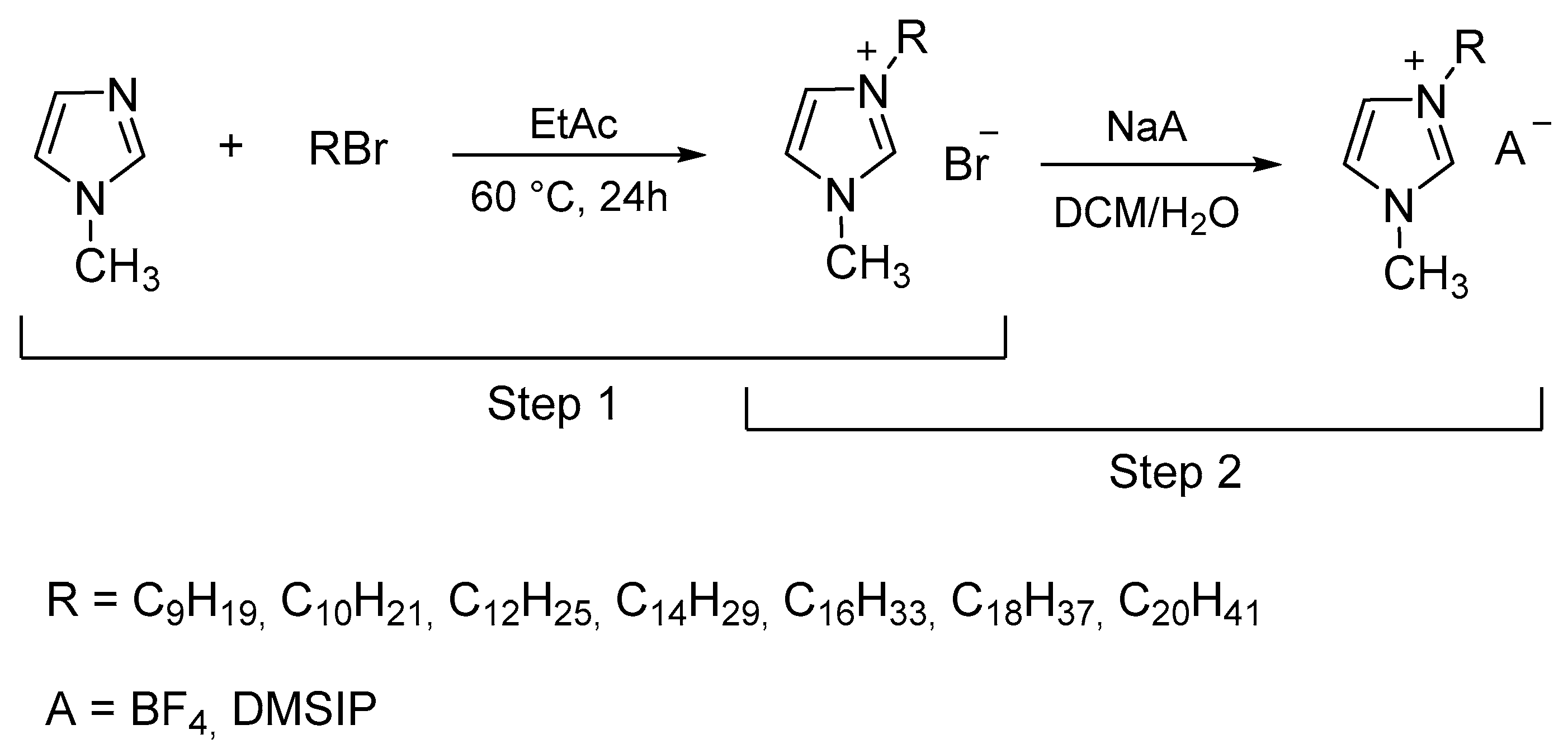


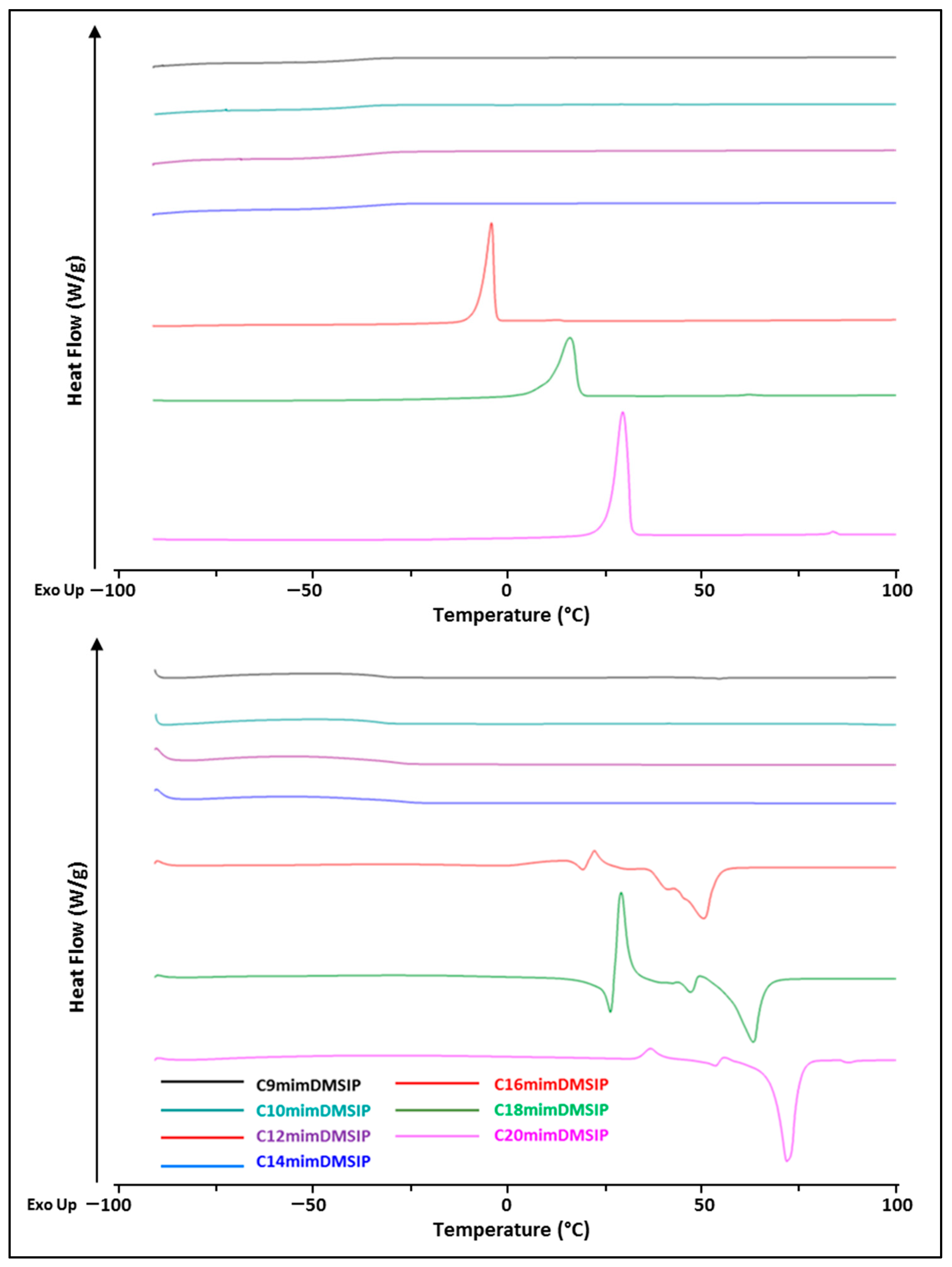
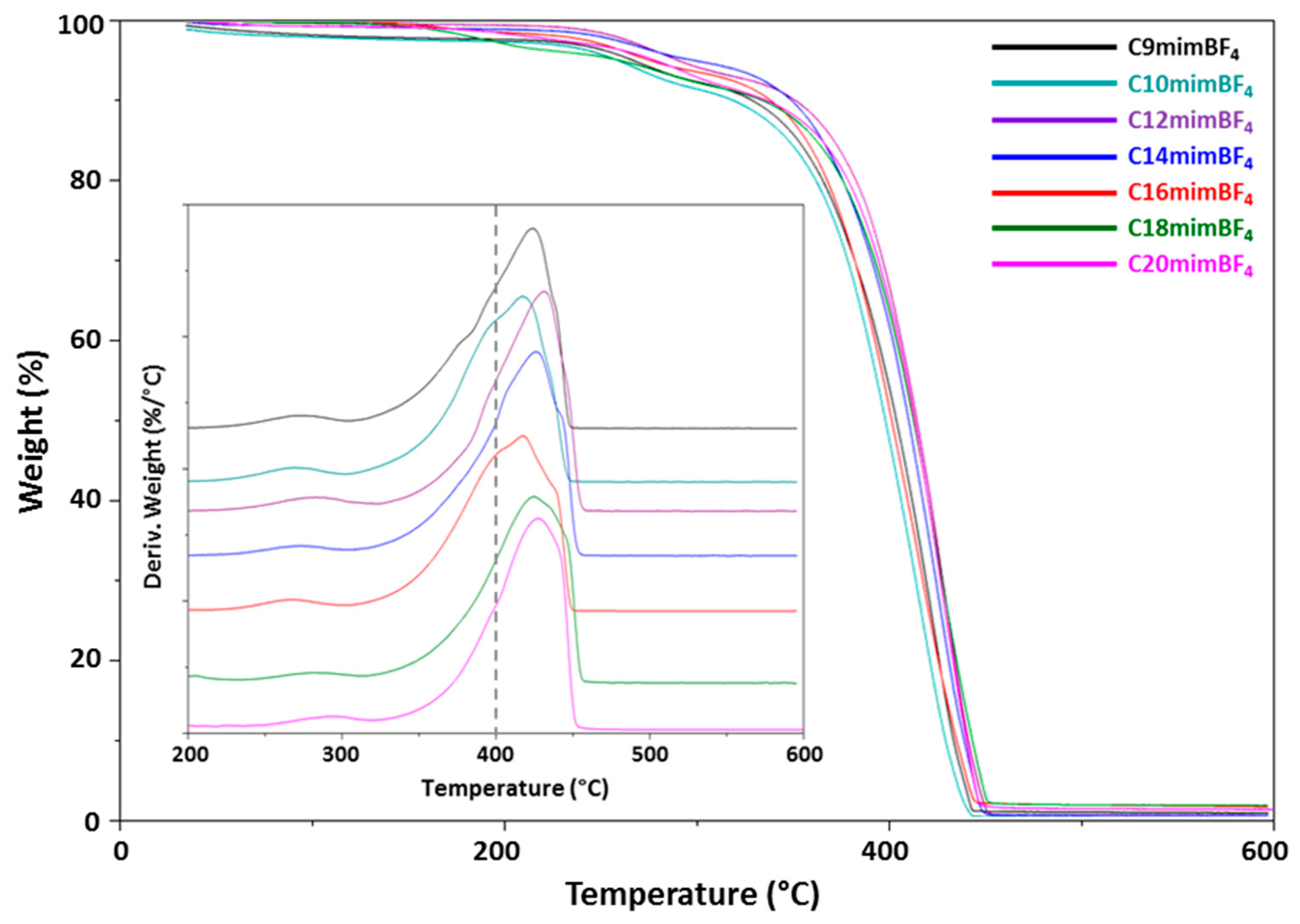
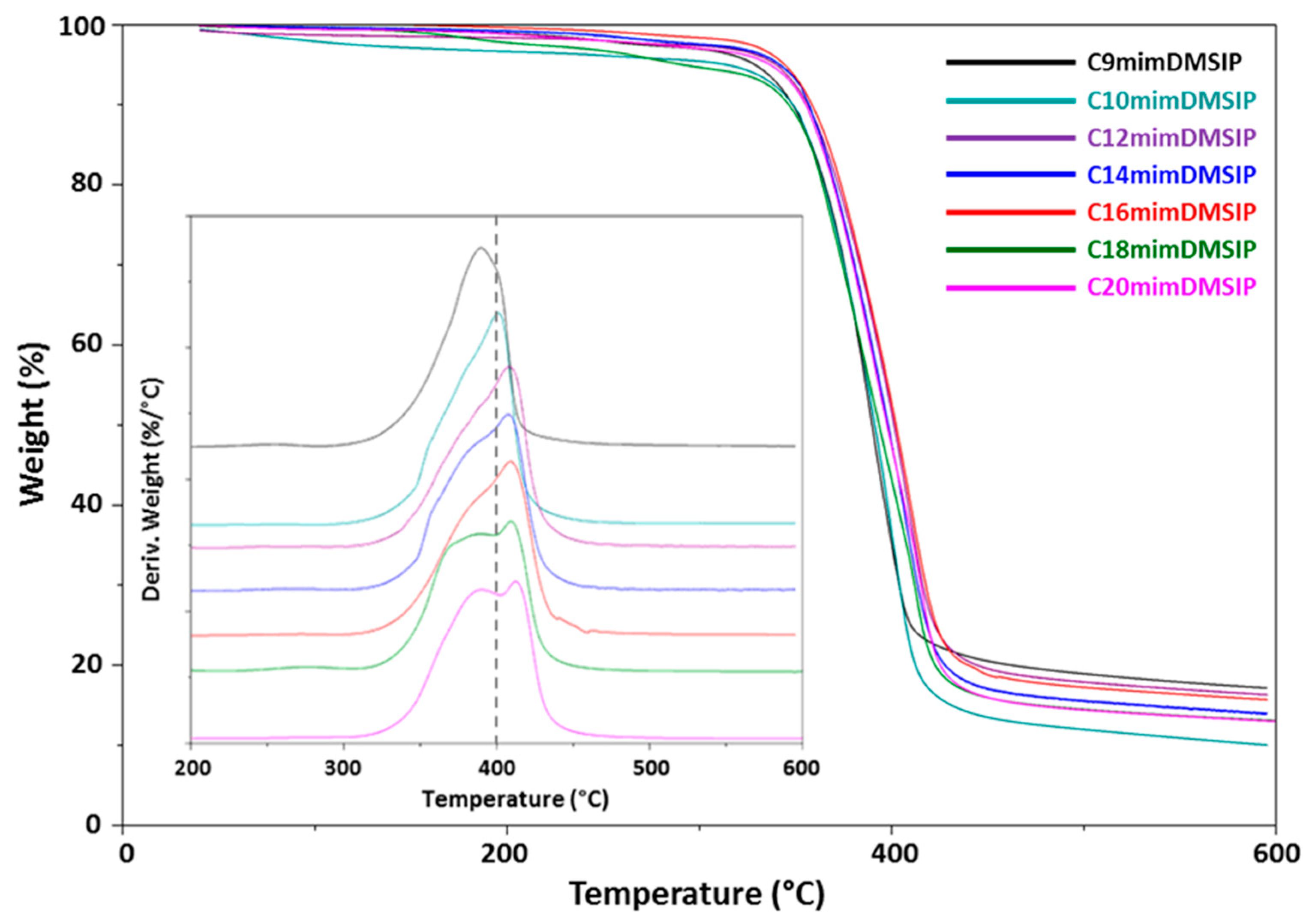

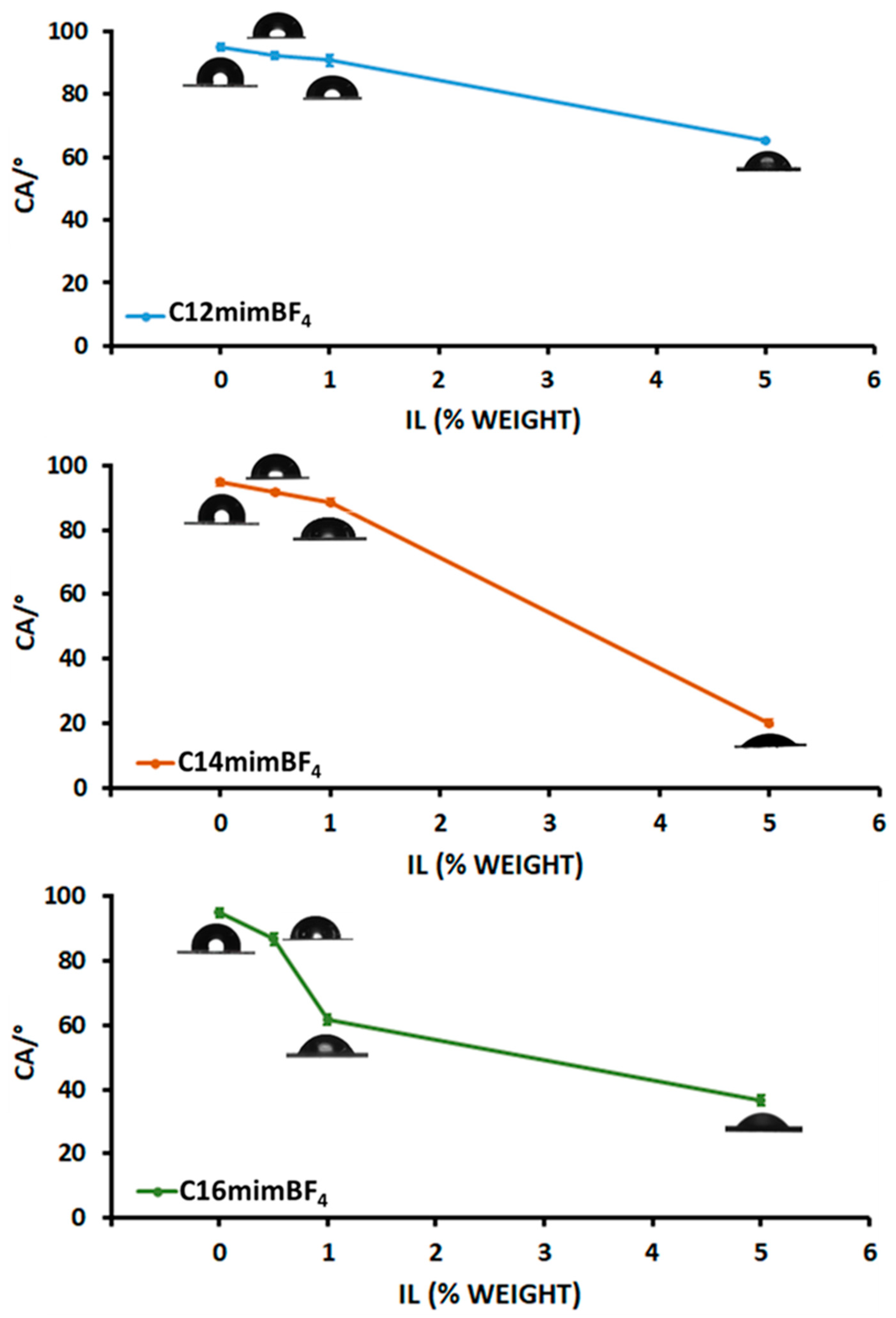

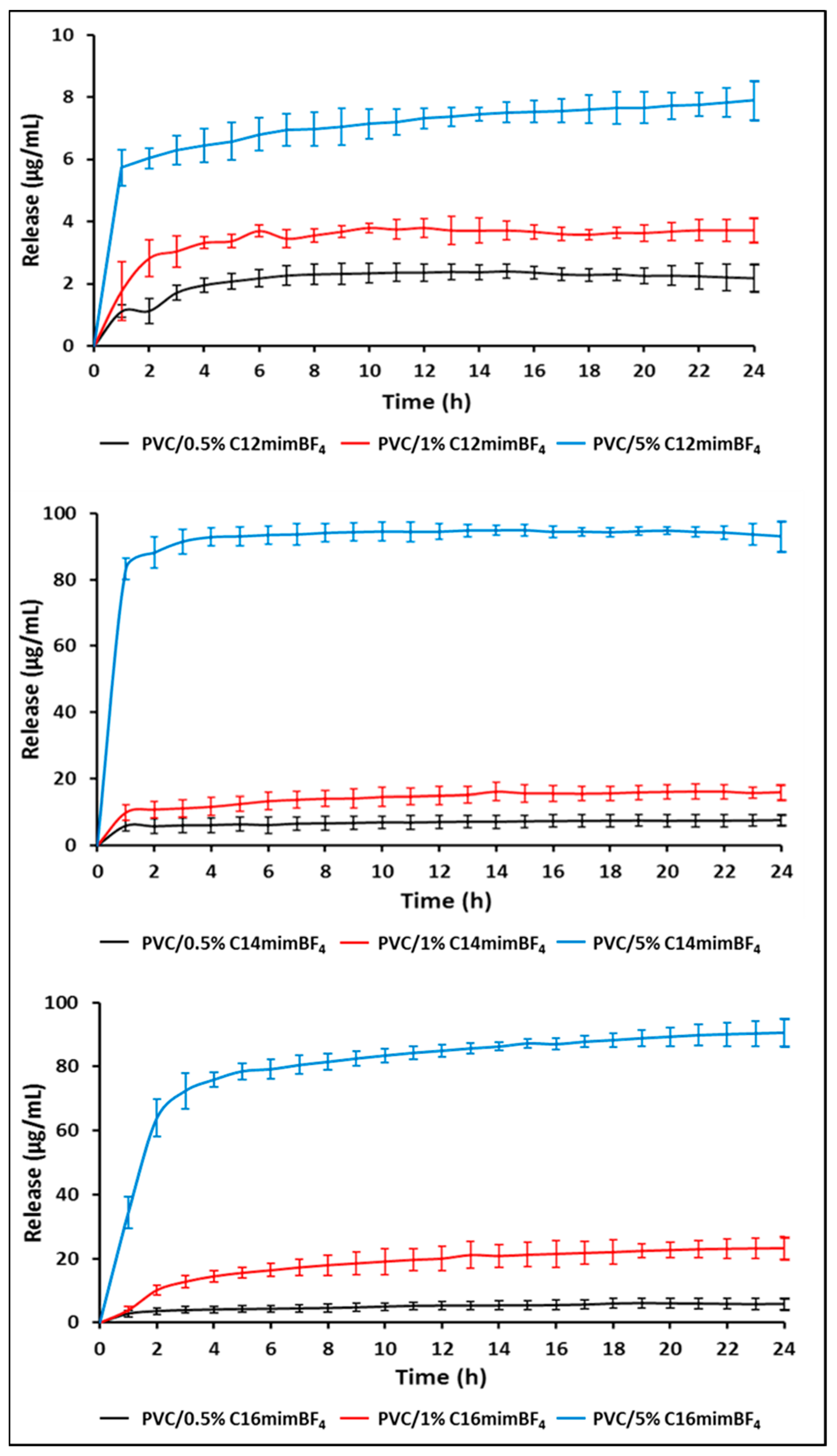
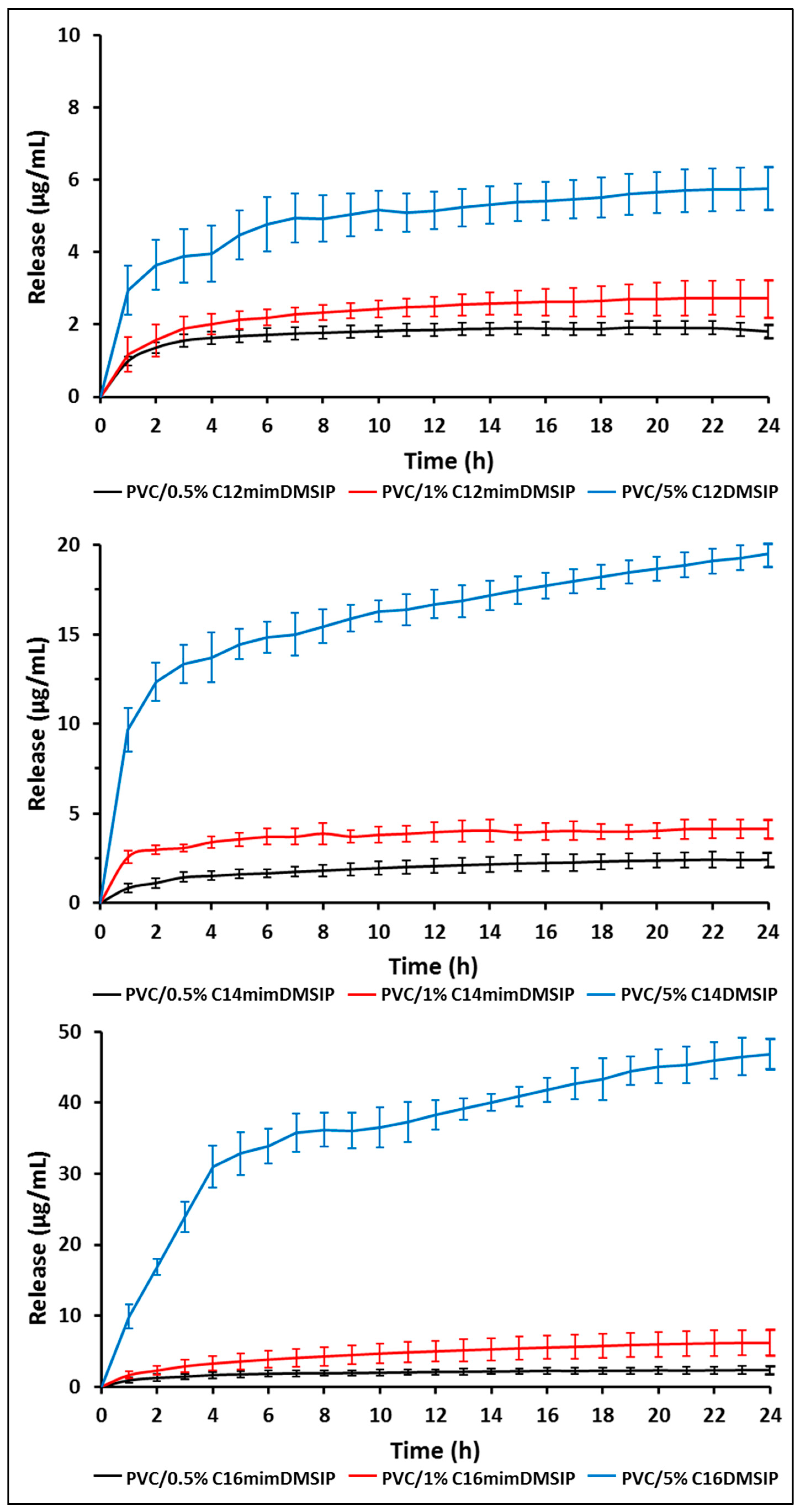




| Cations | Anions |
|---|---|
 | 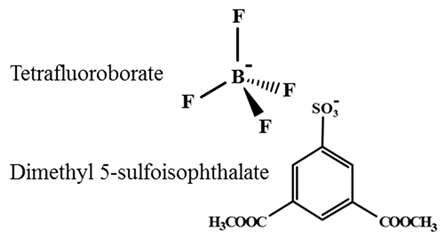 |
| Samples | TΔm=5% (°C) a | Td1 (°C) b | Td2 (°C) c | % R d |
|---|---|---|---|---|
| Neat PVC | 265 | 313 | 461 | 9 |
| PVC/0.5 wt% C12mimBF4 | 231 | 241 | 463 | 7 |
| PVC/1 wt% C12mimBF4 | 228 | 242 | 458 | 4 |
| PVC/5 wt% C12mimBF4 | 216 | 227 | 459 | 5 |
| PVC/0.5 wt% C14mimBF4 | 239 | 253 | 458 | 6 |
| PVC/1 wt% C14mimBF4 | 238 | 252 | 463 | 6 |
| PVC/5 wt% C14mimBF4 | 221 | 234 | 463 | 5 |
| PVC/0.5 wt% C16mimBF4 | 238 | 253 | 460 | 6 |
| PVC/1 wt% C16mimBF4 | 235 | 250 | 463 | 6 |
| PVC/5 wt% C16mimBF4 | 225 | 238 | 466 | 6 |
| PVC/0.5 wt% C12mimDMSIP | 237 | 282 | 458 | 5 |
| PVC/1 wt % C12mimDMSIP | 235 | 255 | 460 | 9 |
| PVC/5 wt % C12mimDMSIP | 221 | 236 | 458 | 9 |
| PVC/0.5 wt% C14mimDMSIP | 242 | 291 | 459 | 5 |
| PVC/1 wt% C14mimDMSIP | 237 | 263 | 456 | 5 |
| PVC/5 wt% C14mimDMSIP | 226 | 244 | 459 | 8 |
| PVC/0.5 wt% C16mimDMSIP | 245 | 285 | 467 | 9 |
| PVC/1 wt% C16mimDMSIP | 244 | 282 | 464 | 9 |
| PVC/5 wt% C16mimDMSIP | 233 | 251 | 465 | 11 |
| Antibacterial Activity µg/mL (µM) | ||||||
|---|---|---|---|---|---|---|
| ILs | Listeria monocytogenes | Escherichia coli | Pseudomonas fluorescens | |||
| MIC | MBC | MIC | MBC | MIC | MBC | |
| C9mimBF4 | 148.08 (500) | 148.08 (500) | 296.16 (1000) | 296.16 (1000) | NI | NI |
| C10mimBF4 | 77.54 (250) | 155.09 (500) | 77.54 (250) | 155.09 (500) | 38.77 (125) | 155.09 (500) |
| C12mimBF4 | 8.46 (25) | 16.91(50) | 16.91 (50) | 84.56 (250) | 16.91 (50) | 42.28 (125) |
| C14mimBF4 | 4.58 (12.5) | 4.58(12.5) | 4.58 (12.5) | 9.16 (25) | 9.16 (25) | 45.79 (125) |
| C16mimBF4 | 19.72 (50) | 98.58 (250) | 9.86 (25) | 49.29 (125) | 49.29 (125) | 98.58 (250) |
| C18mimBF4 | 211.2 (500) | 422.4 (1000) | 52.80 (125) | 105.60 (250) | NI | NI |
| C20mimBF4 | NI | NI | NI | NI | NI | NI |
| C9mimDMSIP | NI | NI | 482.59 (1000) | NI | NI | NI |
| C10mimDMSIP | 124.16 (250) | 496.62 (1000) | 124.16 (250) | 248.31 (500) | 248.31 (500) | 496.62 (1000) |
| C12mimDMSIP | 13.12 (25) | 26.24 (50) | 26.24 (50) | 65.58 (125) | 65.58 (125) | 262.33 (500) |
| C14mimDMSIP | 27.64 (50) | 69.09 (125) | 13.82 (25) | 27.64 (50) | 27.64 (50) | 69.09 (125) |
| C16mimDMSIP | 29.04 (50) | 72.60 (125) | 72.60 (125) | 72.60 (125) | 145.19 (250) | 145.19 (250) |
| C18mimDMSIP | 304.4 (500) | 304.4(500) | 608.83 (1000) | 608.83 (1000) | NI | NI |
| C20mimDMSIP | NI | NI | NI | NI | NI | NI |
| Samples | Listeria monocytogenes Mean (mm) ± SD | Escherichia coli Mean (mm) ± SD | Pseudomonas fluorescens Mean (mm) ± SD | ||||||
|---|---|---|---|---|---|---|---|---|---|
| 0.5% | 1% | 5% | 0.5% | 1% | 5% | 0.5% | 1% | 5% | |
| PVC/C12mimBF4 | NI | NI | NI | NI | NI | 3.7 ± 1.2 | NI | NI | NI |
| PVC/C14mimBF4 | 1.3 ± 0.3 | 2.7 ± 0.4 | 6.0 ± 1.0 | NI | NI | 2.7 ± 0.7 | NI | 1.7 ± 0.7 | 4.3 ± 1.2 |
| PVC/C16mimBF4 | NI | 1.0 ± 0.3 | 2.0 ± 0.5 | NI | NI | NI | NI | NI | NI |
| PVC/C12mimDMSIP | NI | NI | NI | NI | NI | 3.3 ± 0.6 | NI | NI | 2.0 ± 1.0 |
| PVC/C14mimDMSIP | NI | 1.3 ± 0.3 | 2.5 ± 0.5 | NI | NI | 2.7 ± 1.0 | NI | NI | 2.5 ± 0.5 |
| PVC/C16mimDMSIP | NI | NI | 2.0 ± 0.5 | NI | NI | NI | NI | NI | 1.0 ± 0.3 |
| Samples | MCF7 µg/mL (µM) | HDF µg/mL (µM) |
|---|---|---|
| C9mimBF4 | >14.81 (>50) | 5.14 ± 0.10 (17.355) |
| C9mimDMSIP | >24.13 (>50) | 4.96 ± 0.05 (10.28) |
| C10mimBF4 | 7.39 (23.82 ± 1.52) | 4.18 ± 0.03 (13.48) |
| C10mimDMSIP | 5.42 (10.91 ± 1.18) | 5.56 ± 0.04 (11.196) |
| C12mimBF4 | 2.05 (6.062 ± 1.15) | 4.34 ± 0.01 (12.83) |
| C12mimDMSIP | 4.95 (9.44 ± 1.14) | 5.56 ± 0.04 (10.597) |
| C14mimBF4 | 4.41 (12.05 ± 1.42) | 3.78 ± 0.17 (10.32) |
| C14mimDMSIP | 2.91 (5.22 ± 1.43) | 5.56 ± 0.04 (10.059) |
| C16mimBF4 | 1.64 (4.16 ± 1.07) | 8.26 ± 0.03 (20.95) |
| C16mimDMSIP | 3.84 (6.61 ± 1.41) | 5.56 ± 0.04 (9.57) |
| C18mimBF4 | 1.95 (4.61 ± 1.06) | 4.57 ± 0.06 (10.82) |
| C18mimDMSIP | 1.96 (3.22 ± 1.07) | 4.01 ± 0.14 (6.59) |
| C20mimBF4 | 3.47 (7.71 ± 1.27) | 2.70 ± 0.19 (5.99) |
| C20mimDMSIP | 4.71 (7.39 ± 1.41) | 5.10 ± 0.02 (8.008) |
Disclaimer/Publisher’s Note: The statements, opinions and data contained in all publications are solely those of the individual author(s) and contributor(s) and not of MDPI and/or the editor(s). MDPI and/or the editor(s) disclaim responsibility for any injury to people or property resulting from any ideas, methods, instructions or products referred to in the content. |
© 2024 by the authors. Licensee MDPI, Basel, Switzerland. This article is an open access article distributed under the terms and conditions of the Creative Commons Attribution (CC BY) license (https://creativecommons.org/licenses/by/4.0/).
Share and Cite
Novello, E.; Scalzo, G.; D’Agata, G.; Raucci, M.G.; Ambrosio, L.; Soriente, A.; Tomasello, B.; Restuccia, C.; Parafati, L.; Consoli, G.M.L.; et al. Synthesis, Characterisation, and In Vitro Evaluation of Biocompatibility, Antibacterial and Antitumor Activity of Imidazolium Ionic Liquids. Pharmaceutics 2024, 16, 642. https://doi.org/10.3390/pharmaceutics16050642
Novello E, Scalzo G, D’Agata G, Raucci MG, Ambrosio L, Soriente A, Tomasello B, Restuccia C, Parafati L, Consoli GML, et al. Synthesis, Characterisation, and In Vitro Evaluation of Biocompatibility, Antibacterial and Antitumor Activity of Imidazolium Ionic Liquids. Pharmaceutics. 2024; 16(5):642. https://doi.org/10.3390/pharmaceutics16050642
Chicago/Turabian StyleNovello, Elisabetta, Giuseppina Scalzo, Giovanni D’Agata, Maria G. Raucci, Luigi Ambrosio, Alessandra Soriente, Barbara Tomasello, Cristina Restuccia, Lucia Parafati, Grazia M. L. Consoli, and et al. 2024. "Synthesis, Characterisation, and In Vitro Evaluation of Biocompatibility, Antibacterial and Antitumor Activity of Imidazolium Ionic Liquids" Pharmaceutics 16, no. 5: 642. https://doi.org/10.3390/pharmaceutics16050642








